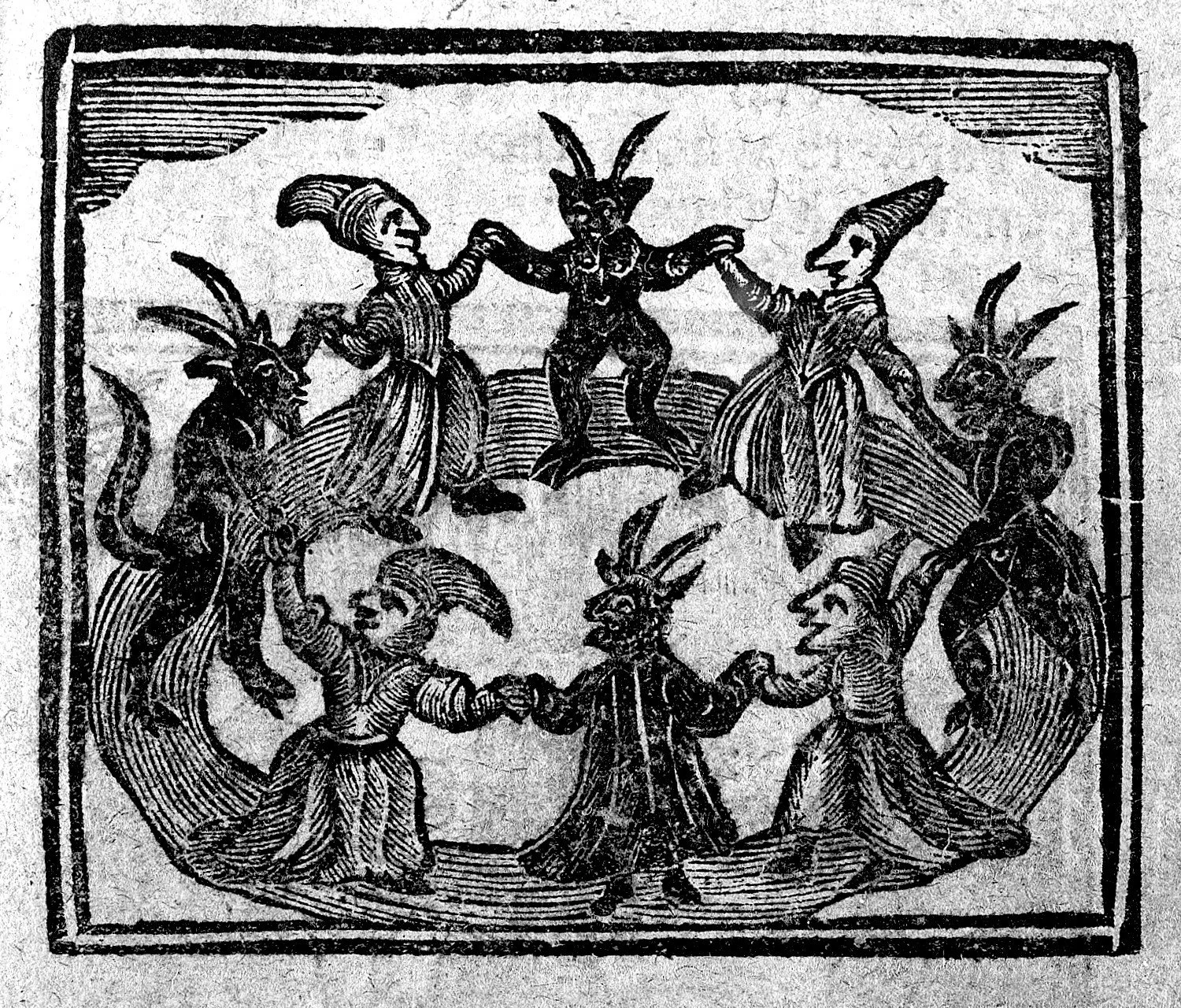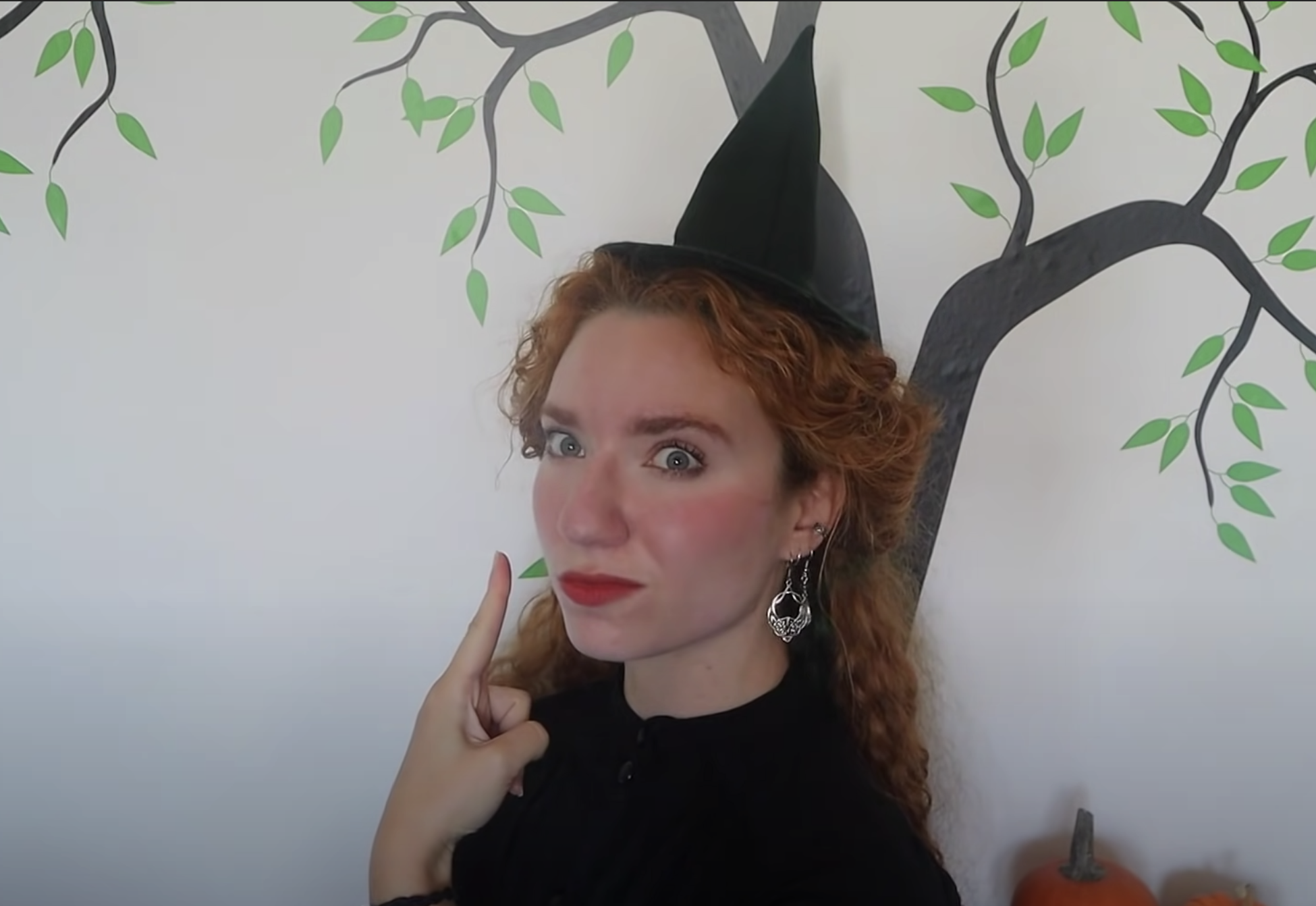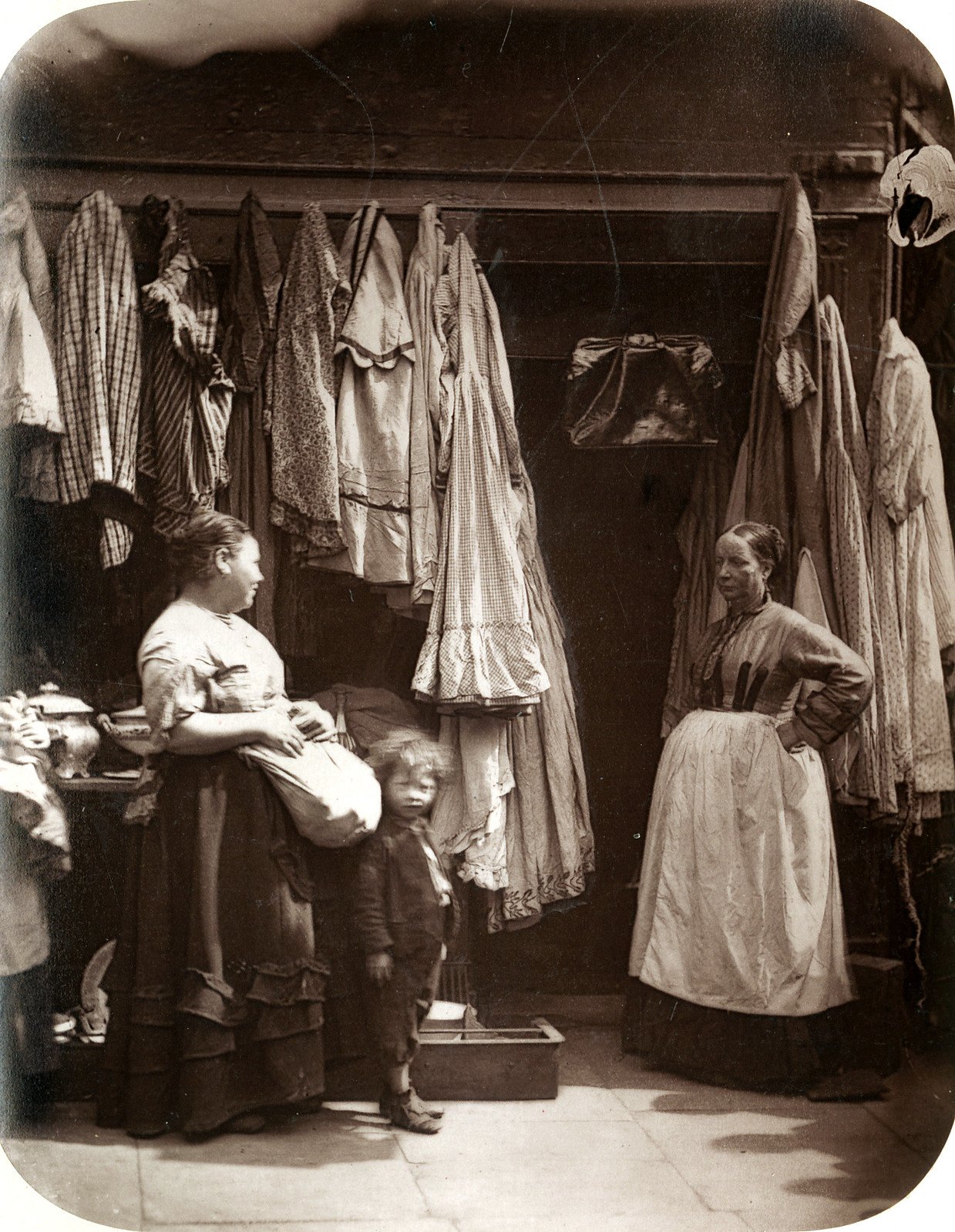Is a Halloween witch costume antisemitic?
Is a Halloween witch costume antisemitic?
The witch halloween costume : pointy witch hat, long hooked nose-- and anti-semitism?! The history of witch costumes and anti-semitic stereotypes goes back further than the witch trials to the middle ages, when Jews and witches were considered one and the same. Turns out, this harmless-seeming witch Halloween costume has a problematic history, and as a Jewish dress historian, I'm here to explain it.
“For the most part, witches and Jews were persecuted interchangeably. Both witches and Jews were perceived traitors to Christian society who must be eradicated.”
Hats, noses, fairy tales, and more
So where does the witch hat come from? What's the history of the witch hat? The history of witches is long, but many of the stories we associate with historical witches go back to the Malleus Maleficarum . . . and the text on anti semitism it was based on, the Malleum Judaeorus (Hammer against Jews). Medieval witches were persecuted interchangeably with medieval Jews, so much of the lore and history of witchcraft in Europe is a recycling of medieval anti-semitism. This includes fairy-tale tropes about witches kidnapping and eating children, how witches have green skin and wild dark curly hair and long hooked noses . . . and the iconic pointed witch hat.
“I’m actually the daughter of the Jews you couldn’t burn.”
Turns out, the historically accurate witch hat was actually a traditional hat worn by Jews, and was then both forced on them by antisemitic laws, and used as visual shorthand for greed, evil, and witchcraft. All of these antisemitic stereotypes and more were applied to the medieval witch, despite the fact that the historical witch was usually just a woman who ran afoul of social prejudices. Add in a couple hundred years of history and politics, the Salem witch trials and European witch craze, and the association of Quakers and witches through the use of those same antisemtic stereotypes, and you have our modern witch halloween costumes.
Okay, but why does this matter today?
If the historical witch was really just a medieval Jew, and the historically accurate witch costume is little other than antisemtism, what does that mean for us? Is it wrong to wear a historically accurate witch hat? Is your witch cosplay hurting people? Honestly . . . it might be. While I see nothing wrong, with enjoying witch history facts, the actual history of the witch trials shows us just how much antisemitism was involved in this outfit. I don't think we need to stop dressing up in witch costumes altogether, but I do think we need to be more aware of the history of the witch costume and the stereotypes we're giving life to when we wear it. If you’re curious about that history, you can find a full bibliography on my Patreon, including all my research notes! It’s important that we don’t forget the prejudices that shaped our world. Unfortunately, these stereotypes are not a long-past part of witchcraft history because they are still hurting Jews today.
-
Halloween is upon us, the season where we pretend to be spooky eldritch horrors for funsies. Perhaps you'd like to celebrate by dressing up as a witch? You'll need the iconic pointy hat . . . a long, hooked nose with some warts for good measure, and then you're a fairytale witch ready to lead innocent children to their doom.
Do you see what's wrong with this picture?
Hi, I'm V, and I like dressing up in really old clothes and nerding out about history. And, don't get me wrong, I love a good witch costume! I love a lot of the aesthetics, I love the symbolization of feminine independence and power . . . but also, I'm Jewish, and there are a lot of antisemitic tropes in our modern image of witches. {aside} I could do without those.
This video exists because about a week and a half ago, a post from JeWitches on the interconnected history of witch trials and antisemitism made the rounds. One of my lovely Instagram followers asked me if modern witch costumes were offensive to Jews because of that. I started poking around on JSTOR so I could give a good answer, and several hours later, I realized there was so much to talk about I couldn't not make a video. I'm gonna be citing texts and papers left right and center, so if you want the full bibliography plus my research notes, you can find that on my Patreon.
I'm gonna head off some common questions right now before I get into things. One : I am not telling you that no one should ever dress up as a witch. That is specifically not what I am saying. I would love to see us all keep dressing up as witches, just, without the nose please. Two : Jews are far from the only cultural group who have been harmed by "witch" stereotyping. The Romani in particular have been persecuted this way and they're not the only ones. I am simply focusing on Jews because, I am one. Three : I am not referring to Pagans, Wiccans, and other folks who call themselves Witches in a spiritual sense the way I call myself a Jew. I'm talking about our Western pop culture ideas of how witches look and act, and the history of how those ideas came to be.
Hookay. What's in this picture? We've got the pointy hat and the long hooked nose, green skin, and wild messy hair. Let's add in some non-visual tropes from witch legends : We've got Hansel and Gretl, where the witch tries to cook and eat unsuspecting children. We've got the 2015 film The Witch, that's got absolutely excellent costuming, and also shows a witch kidnapping a Christian baby and using its body parts for magic. All of these, unfortunately, have their roots in antisemitic imagery and myths. I don't mean casual stereotyping; huge numbers of people were killed as a result of some of these ideas. Past this point, consider this your content warning for frank discussion of some real nasty things, including pogroms, blood libel in all its ugliness, identifying dress, and Nazi propaganda shown for reference. If you don't know what those are or what they have to do with witches, keep watching.
We're gonna have to scroll all the way back to the 15th century and a book called the Malleus Maleficarum*,* or "Hammer of Witches", published in 1486 by Heinrich Kramer. This is one of the best-known books on witch-hunting and was hugely involved in the trials and persecutions of supposed witches in the 16th and 17th centuries. However, the Malleus Maleficarum is actually based on the Malleum Judaeuorus or "Hammer of the Jews", written in 1420 by an inquisitor called John of Frankfurt. According to a paper by Yvonne Owens and a translation of Malleus Maleficarum by Christopher Mackay, "the work lent not only its title but also its formatting and scholarly style to Kramer's book on the persecution of witches”. Dr. Anne Llewelyn Barstow, in her book Witchcraze, says "For the most part, witches and Jews were persecuted interchangeably. Both witches and Jews were perceived traitors to Christian society who must be eradicated". French author Nicholas Jaquier, in his 1581 book A Scourge for Heretical Witches, goes so far as to refer to a gathering of witches as a "synagogam", from the word for a Jewish place of worship. By this point, the Jewish practice of Shabbat (or keeping the Sabbath) had been mischaracterized as a mockery of a Catholic Mass involving devil-worship and blood sacrifices. The idea that Jews had a relationship with the devil goes all the way back to the New Testament, and is still a favorite element of witch legends today. The 16th and 17th century concept of a "witches sabbat" involving . . . devil-worship and blood sacrifices, is a direct parallel. In her paper, Owens describes how identical imagery and tropes were used to demonize both witches and Jews together, including ritual use of blood and menstruation. She cites Irven Resnick's research on the absolutely ridiculous medieval belief that Jewish cis men had menstrual periods. Menstruation in both Jews and in anyone else was considered a major factor in their inclination towards witchcraft because of the "feminine" nature of their "corruption". Furthermore, Owens explains how the planet Saturn and the Roman god it represents were believed to govern both Jews and witchcraft. Here's an image from 1513 by Hans Baldung Grien of Saturn depicted as a Jew . . . does the hat resemble anything? Maybe this?
Now, I don't actually want to spend too much time on the pointy witch hat, because it's usually where the discussion starts and ends. There are much more harmful antisemitic stereotypes in our pop culture witch stories; the hat's kind of just a symbol. The earliest images of this hat specifically on a witch are a series of woodcuts from the book The History of Witches and Wizards by someone known as W. P. in 1720. However, this is not our first image of the hat! This illustration from Hortus Delicarum, a 12th-century German manuscript, shows two German Jews wearing tall, conical hats with round brims— it's pretty much the same hat. From what we can tell this was originally a cultural style created and embraced by Jews themselves, and it's included in Jewish art that dates from before the Judenhut, or "Jewish Hat" in German, was ever used in antisemitic laws. The Fourth Council of the Lateran, convened by Pope Innocent III in 1215 passed a sumptuary law requiring Jews to wear identifying dress in all Christian territories, but different countries and cities required different items of clothing. If you remember my video about Jewish medieval veils, the law requiring the blue-bordered veil in Rome and the Papal States was a reinforcement of the Fourth Council. Enforcement was left up to local authorities, so it could be yellow badges, red capes or red aprons . . . In Vienna, Breslau, Nuremberg, and Erfurt, as well as other German-speaking territories, it was the Judenhut that was required. Through the middle ages, as the association between Jews and "feminine" evils like witchcraft developed, it brought with it the stereotypical image of Jews, including the pointy hat. The Judenhut and its imagery were still in use in the 16th century, as shown in Hans Baldung Grien's picture of Saturn as a Jew.
One of the other theories about how conical hats became associated with witches has to do with 17th century Quaker women, who often wore hats that looked like the black witches hat, but without a point. I don't disagree with this theory because it comes right back to antisemitism. Quakers were seen as heretics and a threat to the social order of English society, and Quaker women were particularly demonized for taking active roles in religious and community leadership. Accusations of witchcraft were a established way of putting outspoken women back in their places— Kramer, who wrote Malleus Maleficarum, famously tried a woman for witchcraft because she disliked his sermons— and there was an established set of imagery to use for these accusations, thanks to the popularity of Kramer's book. Even though Jews had been forbidden to live in England since 1290, the same antisemitism was present there as in the rest of Europe : see Shakespeare's The Merchant of Venice from 1596 and Christopher Marlowe's The Jew of Malta from 1590. It's also worth noting that around the same time as this anti-Quaker sentiment, in 1656 or so, Jews were granted tacit permission from the Crown to resettle in England. Religious factions argued vehemently about this, and the "mother of Quakerism" Margaret Fell wrote in favor of the Jews returning (although only on the condition that they converted). It wasn't that Jews and Quakers were both separately accused of witchcraft. The demonization of witches through anti-Jewish stereotyping had already happened, and now it was being reused. When the push to portray Quaker women as witches got going, applying this familiar antisemitic witchy imagery was a super efficient way to do it, especially in context with the panic over Jewish resettlement and Quaker support for it. Someone must have pointed out it wasn't too much of a jump from these hats without points to the Judenhut with one. The artist of these woodcuts from 1720 clearly did their research, because, these hats worn by the masculine figures sitting with the witches? These are another form of the Judenhut which, according to a paper by Naomi Lubrich, went through numerous regional variations in the later middle ages as Jews tried to reclaim it from the antisemitic sumptuary laws. Put all these things together? Boom. Pointy-hat-wearing, devil-worshipping, blood-sacrificing witches.
Another thing that has roots in the 17th and 18th centuries is the idea of the "Jewish nose" as an ethnic identifier— it goes back as far as the 13th or 14th century, but really caught on during the Enlightenment. Talking about this is going to be really weird, because as a Jew with a dramatic aquiline nose, it's so strange to have to actually . . . say . . . any . . . of this . . . Nonetheless. Prominent, aquiline, or "hooked" noses are considered a common ethnic feature among Jews. Not all Jews have them— it seems to be more of a generally Mediterranean characteristic, and in studies from the 20th century it was found that aquiline noses were just as prevalent among non-Jewish Mediterranean populations as they were among Jews from the same places. In Western European beauty standards, prominent or curved noses have long been considered "ugly" at best. In 20th century America, it was common for Jewish girls to have "bicycle accidents" around their 16th birthday, during which they "broke their noses" and therefore needed surgery. Apparently in Ancient Rome aquiline noses were actually considered attractive? So now I'm wondering how much of their ugliness in Western beauty standards actually comes from their becoming associated with Jews . . .
. . . Anywhoo. A huge amount of antisemitic imagery uses exaggerated aquiline noses as a visual identifier for Jews, connecting Jewishness with ugliness, greed, and all sorts of other undesirable characteristics. This goes back at least to the middle ages; here's an illustration of Psalm 53 in the Psalter and Hours of Bonne of Luxembourg from around 1340. To further illustrate my point : here is a fake "witch" nose sold as a Halloween costume accessory. And here is a piece of Nazi propaganda from Der Stürmer in 1928. See the similarities?
If I have to explain why we should really really not want to look like Nazi propaganda . . . I don't know if there's any point to continuing this video. We know Nazis are bad, right? We know we don't want to be like them, in any way? Do we?
Two other features we see in today's witch imagery are wild, tangled, dark hair, and green or greenish skin. These are also stereotypes of Jews— I'm gonna toss up another piece of Nazi propaganda to show you what I mean. Like the aquiline nose, darker and curlier hair and olive complexions are broadly Mediterranean traits, but they became part of the stereotypical image of a Jew in the middle ages as another way of othering Jews from Northwestern Europeans. Features like the hooked nose, the hair, and interpersonal stereotypes are often applied to fairytale villains who are not explicitly Jewish, which just furthers the cultural association between these features, and "evilness".
I'm gonna move on from strictly visual tropes to things like myths and stories about witches— and this is where it gets real messy. The "luring and killing sweet innocent European children and consuming their flesh" thing? You probably recognize it from Hansel and Gretl. It has a name : "blood libel", which is a particular kind of antisemitic rumor used to justify violence towards Jews. I touched on this a little in my video about getting dressed in the middle ages while Jewish. The first documented instance of blood libel was in England in 1144, less than a hundred years after Jewish communities were invited to settle there by William the Conqueror. Here's the usual format : A Christian child (occasionally an adult, but usually a child) goes missing or is found dead. The local Jewish community are accused of kidnapping and killing the child for ritual purposes, often using the blood of the murdered child for all sorts of improbable things like baking matzah, those devil-worshipping anti-Christian Masses, and curing menstruation in Jewish men, that absurd rumour we talked about earlier. Varying degrees of violent reprisal follow, ranging from legally-sanctioned executions of a few individual Jews to pogroms which threatened, drove out, or massacred the entire Jewish community in the area. In at least three of these cases there was an effort to make the murdered Christian child a saint, and one succeeded. The story of the blood libel was firmly established by the time the European "witch craze" developed in the 15th and 16th centuries. After that first incident in England, blood libels spread to continental Europe in less than 30 years, with at least ten more documented cases before the year 1500. Heinrich Kramer, the Dominican monk who wrote Malleus Maleficarum, was involved in one of the most famous blood libel trials of the Renaissance : Simon of Trent, a two-year-old Christian boy from present-day Trento in Northern Italy, disappeared shortly before Easter in 1475. His body was found and reported on Easter Sunday by the local Jewish community . . . who were then tried, declared guilty, and 15 of them were burnt at the stake. Side note— this trope is alive and well, last year an Italian painter created a work based on the Simon of Trent blood libel, with all the antisemitic symbolism. Kramer was clearly inspired by this trial, says Yvonne Owens in her paper, which is only further evidenced by having modeled his book on witch-hunting after the earlier "Hammer of the Jews". These beliefs about the behavior of witches didn't come about independently— they were a recycling, in Kramer's case a deliberate one, of previously existing antisemitic myths.
Hopefully by now you can see how the archetype of the blood libel story lives on in fairytales like Hansel and Gretl, or in popular media like The Witch movie. I wish I could say that these were just stories, and that the real blood libels ended long ago, but . . . they didn't. Blood libels that resulted in pogroms against Jews are documented as recently as 1910, and of course during World War II. And this is only one particularly frightening cause of antisemitic violence : Public attention on Jews, whether it's one Jew or the whole community, has frequently been followed by a wave of antisemitism. If something as unrelated as a missing Christian kid could get your entire community slaughtered, can you imagine what happened if a Jew took a public position on something and non-Jews didn't like it?
[aside] Pogroms. The answer is pogroms.
The modern legacy of the blood libel is that public attention towards Jews, individually or collectively, is risky even now. We still regularly get accused of secretly ruling the world, controlling financial markets, the literal present-day blood libel that is QAnon. If one individual Jew does something awful, as individuals of every demographic sometimes do, Jews as a whole are considered guilty. There has been a well-documented rise in antisemitic violence over the past two decades. A few years ago there was a synagogue shooting that killed 11 prominent Jews in their community, on my birthday— so you can understand why I have some feelings about this. And on a more everyday level, when a Jew speaks up about antisemitism, there is always someone (or many someones) ready to say the Jew is overreacting, there's another explanation, antisemitism doesn't happen anymore, whoever did the thing had good intentions . . . or to derail the conversation using a different antisemitic trope. The opinions of non-Jews as to whether something is or is not antisemitic are prioritized over the experiences of Jews . . . who are literally the world's foremost authorities on antisemitism, because we live with it our whole lives. And if there is variation in how individual Jews feel about something— which there always is, because no demographic is a monolith— the Jewish voices willing to excuse or ignore the problem are tokenized, and all the others are disregarded or discredited. To quote Zo Jacobi of Jewitches, "If we don't agree amongst ourselves on a specific thing, how are you, someone not in the community, going to pass judgement as if you have any authority?".
I will not pretend that I'm not really nervous about posting such a direct criticism of a popular cultural archetype. There are a lot of people who are going to be super uncomfortable watching this! But it needs to be said. These stereotypes, these images, are still hurting people, both in a more literal sense (like the mess that is QAnon) and through generations of symbolism and trauma. Tangled and The Witch didn't come out that long ago, and I found this fake nose last week, so this is not a problem of the past. Some people might be wondering "why does she have to make everything about Jews?". To that, I say, "why do antisemites have to make everything about Jews?". We've been trying to mind our own business for the past couple millennia, it's other folks who were the source of all these damaging myths.
So do I think we need to stop dressing up as witches? No, of course not. Often times, when the not-so-pretty story behind something gets explained, there's this response of "so we can never do that thing again, ever, at all? You're ruining this thing for everyone!". This is a common straw-man argument to discredit and misrepresent those who are trying to educate, by acting like we are making an unreasonable demand. So firstly, please be on the lookout for those sorts of accusatory questions. And secondly I want to be absolutely clear : That is not what I am saying. There is so much more to the concept of a witch than these antisemitic tropes, and I am not suggesting we throw metaphorical babies out with bathwater. I think this just goes to show how much meaning and history our clothes and costumes can carry— and this is true of any and all costumes, not just witches or Halloween. Nothing exists in a vacuum. Costumes and fashion developed the way they did because of the context and culture around them, and that meaning is woven into their fibers. So be aware of what aspects of our "witch" imagery and legends you're representing. I have no strong feelings on the pointy hat— as you can see, I own one— but that's just one Jew's opinion, and the saying "ask two Jews, get three opinions" doesn't exist for nothing. The fairy tales about kidnapping children? Joking about blood sacrifices? Be reeeaaal careful. And the nose?
The nose needs to GO.
Thank you for dropping by for your regularly scheduled installment of "Noisy Jewess Teaches About Fashion History". If you like learning about the reality behind costumes, be they Halloween or historical, subscribe, because that's what we do here! Don't forget to leave a like, share this video with your witchy friends, and tell me in the comments about a witch costume you love that celebrates the positive side of this age-old archetype. I will see you soon with a video on making my Halloween costume! Bye~





